This list provides Great Lakes and Upper Midwest gardeners with 10 reliable, adaptable and site-specific perennials. Whether you have heavy clay, loam or sandy soil or are gardening in the shade, there’s something here for you. And, as a bonus, all of these native plants excel at attracting pollinators, and when used in combination, they can provide season-long color and interest in the garden. There is no perfect top-10 list of essential plants for a given region; consider the growing conditions in your own garden or landscape, and choose plants suited to those conditions.
Not in the Great Lakes or Upper Midwest? Browse plants native to other regions of the U.S.
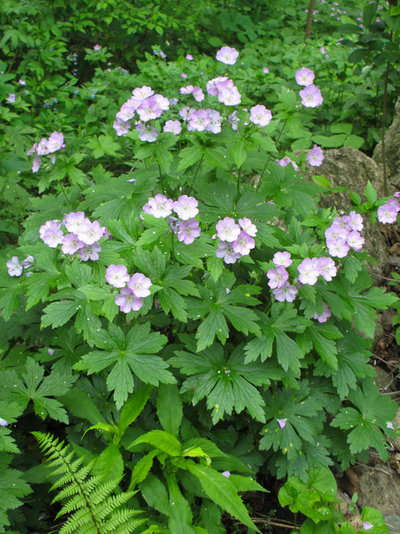
Holm Design & Consulting LLC
Wild Geranium(G
eranium maculatum)
Native from Manitoba, Canada, south to Oklahoma and eastward to Quebec in the north and Georgia in the south
Best plant to grow in shade. With its mounding form and large light to medium pink flowers, wild geranium makes a colorful addition to a shade or woodland garden.
This perennial can be used in masses under trees, along woodland edges or incorporated into any shade garden. Because it flowers later than the first spring ephemerals, such as Dutchman’s breeches (
Dicentra cucullaria), it can be planted in combination with these earlier-flowering plants to help fill the void after the ephemerals go dormant.
See how to grow wild geranium
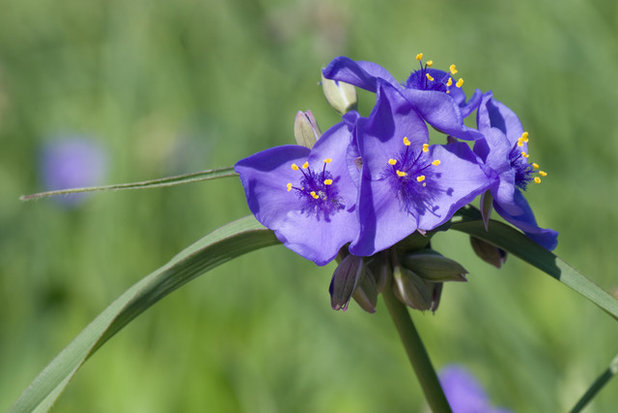
Holm Design & Consulting LLC
Ohio Spiderwort(
Tradescantia ohiensis)
Native to eastern North America; the western part of the range includes Nebraska south to Texas, also occurs from Minnesota eastward to Maine, including Ontario in Canada (absent in Vermont) in the north; endangered in Pennsylvania
Best plant for clay. Ohio spiderwort is very adaptable and can grow and thrive in most soil types, including heavy clay. The bright blue, pink or purple flowers provide color and interest in the spring, opening in clusters in the morning, then closing up in midday when temperatures rise. The grass-like, linear foliage provides textural interest and complements broad-leaved perennials.
See how to grow Ohio spiderwort
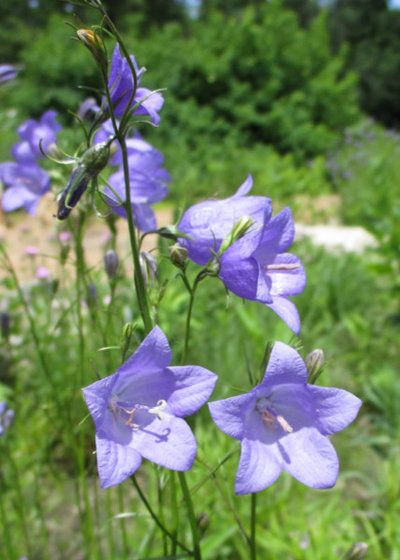
Holm Design & Consulting LLC
Harebell(
Campanula rotundifolia)
Native to all of North America except the following states: Nevada, Kansas, Kentucky, Oklahoma, Arkansas, Louisiana and states eastward to Georgia, including Florida
Best plant for sand. Harebell has delicate, fine foliage with many thin, linear leaves. The nodding blue flowers are typically held singly on the flower stalks. Harebell flowers in late spring and will rebloom throughout the summer.
Mass plants together for the best display in the garden. Harebell is an excellent native plant for sandy soil and tight spaces, such as gaps in a boulder wall or along the top edge of any hardscape retaining wall. It is also a good choice for use along a sidewalk or walkway, because it tolerates the heat generated from the hardscaping and will not flop over or overpower a path.
See how to grow harebell
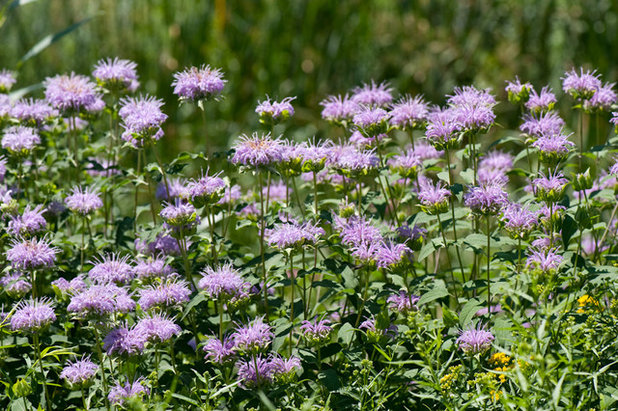
Holm Design & Consulting LLC
Wild Bergamot(
Monarda fistulosa)
Native to all of North America except Alaska, the Yukon and Nunavut Territories, New Brunswick, Nova Scotia, Prince Edward Island, Newfoundland, Labrador, California and Florida
Best plant for loam. Wild bergamot (
Monarda fistulosa) is one of the most resilient North American native plants and is a delight for bumblebees and butterflies. It can be used in a variety of situations, including butterfly and pollinator gardens, perennial borders and informal meadow or prairie plantings. It thrives in loam soils and full sun.
See how to grow wild bergamont
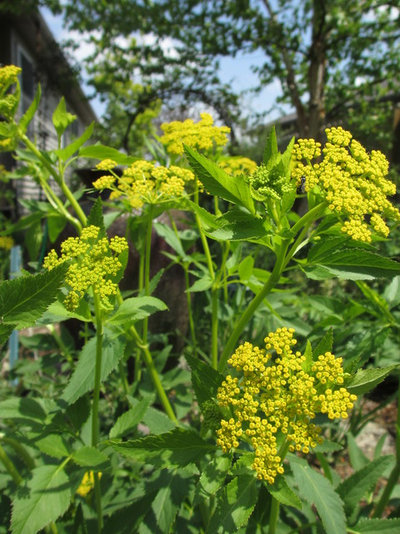
Benjamin Vogt / Monarch Gardens
Golden Alexanders(
Zizia aurea)
Native from the eastern Dakotas south to eastern Texas and east to the Atlantic and New England
Best plant for spring. Golden Alexanders is an extremely versatile native plant that flowers in spring, often when we need additional color in the garden, and provides forage for pollinators. It grows in most soil types and is relatively shade tolerant, growing well in partial shade.
Use this plant massed together along a house foundation, in a perennial border, at the edge of a woodland or in an informal prairie planting. Once the plant is finished flowering, its seed heads provide additional interest from late summer through winter. Golden Alexanders is an important pollinator plant, as it is a larval host plant to some swallowtail butterflies and a specialist plant for solitary bees.
See how to grow golden Alexanders
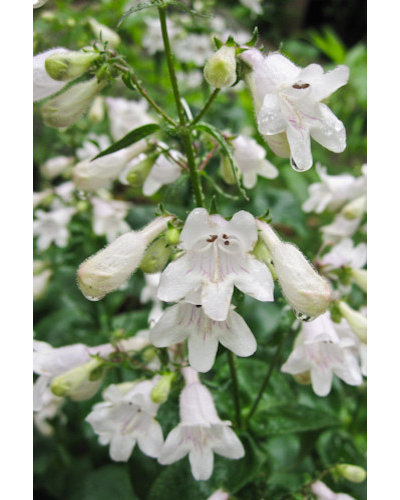
Holm Design & Consulting LLC
Foxglove Beardtongue(
Penstemon digitalis)
Native to eastern North America, except Florida; the western part of its range includes South Dakota south to Texas
Best plant for late spring. Foxglove beardtongue has large, bold white flowers that are arranged in clusters, called panicles, on each flower stalk. The flower stems are sturdy and remain upright long after the flowers have faded. The bright green glossy leaves clasp the flower stalk, forming ladder-like tiers.
Foxglove beardtongue can be used in a perennial border or in an informal prairie or naturalized planting. Its medium height and white flowers are a welcome colorful addition in early spring. The flowers typically open in May, bridging the gap between the early woodland flowers and perennials that shine in midsummer.
See how to grow foxglove beardtongue

Holm Design & Consulting LLC
Anise Hyssop(
Agastache foeniculum)
Native to the northern portion of North America, including Washington, Montana, Wyoming, Colorado, North Dakota, South Dakota, Nebraska, Minnesota, Iowa, Wisconsin, Michigan, Illinois, Kentucky, Delaware, Pennsylvania, New York and New Hampshire in the U.S.; occurs in all of the Canadian provinces except Newfoundland, Nova Scotia and Prince Edward Island
Best plant for summer. Anise hyssop provides color throughout the summer; it begins flowering in late June and continues to flower until the beginning of September. It attracts a diversity of pollinators, including bees and butterflies.
Anise hyssop is best used in medium to dry locations where no standing water occurs. Use it on hillsides, along sidewalks or garden borders, in butterfly or pollinator gardens, or on the dry upper edges of rain gardens.
See how to grow anise hyssop

Holm Design & Consulting LLC
New England Aster(
Symphyotrichum novae-angliae)
Native to all of North America except Alaska, Idaho, Nevada, Arizona, Texas, Louisiana and Florida in the U.S.; in Canada does not occur in Newfoundland, Prince Edward Island, Alberta, Saskatchewan or the Canadian territories
Best plant for fall. New England aster produces light pink to deep purple flowers from August to October. Use New England aster next to goldenrods (
Solidago spp) for an outstanding flower color contrast.
It performs best in moist sites, including rain gardens, ditches, pond and wetland edges, and other low-lying sites where water collects after a rainfall. Drier sites are tolerated if the soil has a higher clay content. This plant’s preference for moist sites is more apparent in the upper Midwest.
See how to grow New England aster
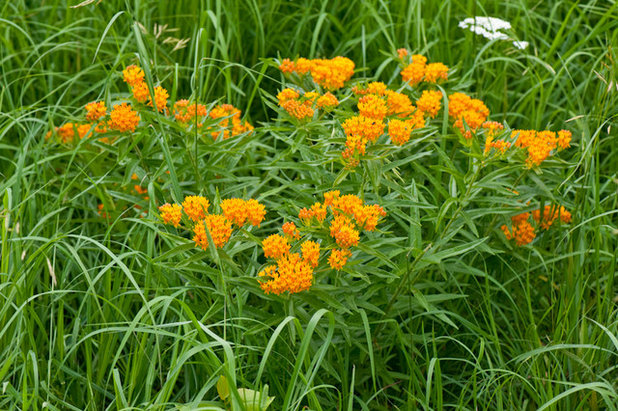
Holm Design & Consulting LLC
Butterfly Milkweed(
Asclepias tuberosa)
Native to most of North America except for the northwestern U.S. states and Canadian Atlantic and northwestern provinces
Best plant for eye-popping color. Few plants can match the vividness of butterfly milkweed’s orange flowers. Combine butterfly milkweed with any blue- or violet-flowering native plant for an outstanding color contrast.
Butterfly milkweed grows best in well-drained soil that’s free of compaction or clay. Use it in perennial borders or mass it in swaths in both formal and informal plantings. This perennial also looks at home in a rock garden, surrounded by various-size rocks or boulders.
See how to grow butterfly milkweed
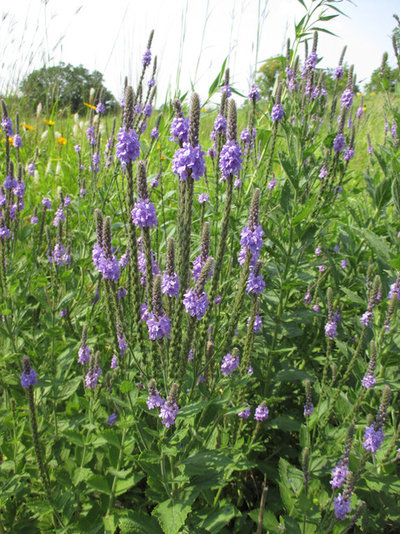
Holm Design & Consulting LLC
Hoary Vervain(
Verbena stricta)
Native to most of the U.S. except Oregon, California, Louisiana, Florida, South Carolina, Maryland, Virginia, New Hampshire and Maine; also grows in Ontario and Quebec
Best plant for tough sites. Hoary vervain thrives in tough sites, including soils compacted from foot traffic and heat generated from hardscaping, such as asphalt. It is a very drought-tolerant native perennial.
Hoary vervain is best used in sites that are dry and have well-drained, sandy oil. Combine it with yellow-flowering native plants, such as black-eyed Susan (
Rudbeckia hirta), smooth oxeye (
Heliopsis helianthoides,
shown) or gray-headed coneflower (
Ratibida pinnata).
See how to grow hoary vervain





